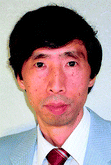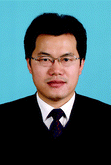Organocatalysis: a web collection
Keiji
Maruoka
a,
Benjamin
List
b,
Hisashi
Yamamoto
c and
Liu-Zhu
Gong
d
aDepartment of Chemistry, Graduate School of Science, Kyoto University, Kyoto, 606-8502, Japan. E-mail: maruoka@kuchem.kyoto-u.ac.jp; Tel: +81-75-753-4041
bMax-Planck-Institut für Kohlenforschung, Kaiser-Wilhelm-Platz 1, D-45470 Mülheim an der Ruhr, Germany. E-mail: list@mpi-muelheim.mpg.de; Tel: +49-208-306-2411
cDepartment of Chemistry, The University of Chicago, 5735 South Ellis Avenue, Chicago, IL 60637. E-mail: yamamoto@uchicago.edu; Tel: 773-702-5059
dHefei National Laboratory for Physical Sciences at the Microscale, Department of Chemistry, University of Science and Technology of China, Hefei, Anhui 230026, P. R. China. E-mail: gonglz@ustc.edu.cn; Tel: +86-(0)551-3600671
 Keiji Maruoka | Keiji Maruoka is currently Professor of Chemistry at the Graduate School of Science, Kyoto University. His research focuses on bidentate Lewis acid chemistry, asymmetric phase-transfer catalysis, and the design and synthetic utility of high-performance organocatalysts. |
 Benjamin List | Prof. Dr. Benjamin List, is the managing director of the Max-Planck-Institut für Kohlenforschung in Mülheim an der Ruhr, Germany and a honorary professor of chemistry at the University of Cologne. His research focuses on developing new catalysis concepts. |
 Hisashi Yamamoto | Professor Hisashi Yamamoto is chairman of the Molecular Catalysis Center at Chubu University, Japan, Emeritus Professor at the University of Chicago, USA, and Emeritus Professor at Nagoya University, Japan. He is interested in the area of chiral Brønsted acid catalysts, N-Nitroso Aldol (N-NA), and O-Nitroso Aldol reactions. |
 Liu-Zhu Gong | Liu-Zhu Gong is currently a Changjiang Scholar Professor of organic chemistry at the University of Science and Technology of China. His current research interest is focused on the organo- and transition metal-catalyzed asymmetric synthesis and total synthesis of natural products. |
The exploitation of new catalysts and new organic transformations in an environmentally benign manner has became crucially important in recent years for the construction of new and useful organic structures from versatile starting materials. In this context, organocatalysis has recently emerged as a powerful synthetic paradigm in order to fill a gap between metal- and enzyme-catalysis, thereby providing practical alternatives or complementary technologies to the more traditional transition metal-catalyzed systems. Organocatalysis is an attractive method to synthesize complex organic molecules: it is operationally simple, has low associated toxicity and organocatalysts are simple to handle and store. In addition, a wide variety of organocatalysts are now commercially available, which will further stimulate the wide application of such organocatalysts for selective organic transformations in a broad manner. Indeed, organocatalysis has seen a tremendous rise in popularity when measured in recent scientific publications. A tremendous amount of new experimental findings have been published at a breathtaking pace over the last several years which implies the “golden age” and “gold rush” of the organocatalytic field.
The communications and feature articles in this web collection cover important up-to-date information on organocatalysis, and sketch the fruitful development of this exciting field. In particular, the major contributions originated from (1) enamine and iminium catalysis; (2) SOMO and radical enamine catalysis; (3) amine, DMAP and phosphine catalysis; (4) carbene-catalysis, ketone and iminium salt catalysis; (5) organocatalysis using guanidine, amidine and Cinchona alkaloids; (6) organocatalysis with Brønsted acids, thiourea and peptides; and (7) phase-transfer catalysis. In addition, several one-pot multi-step procedures lead to highly functionalized products of wide synthetic applicability. The articles in this issue demonstrate a high, yet sophisticated level of activity in addition to the scope and limitations of this promising field. Accordingly, the readers will enjoy reading the most recent and exciting findings in the current organocatalytic field.
| This journal is © The Royal Society of Chemistry 2012 |
